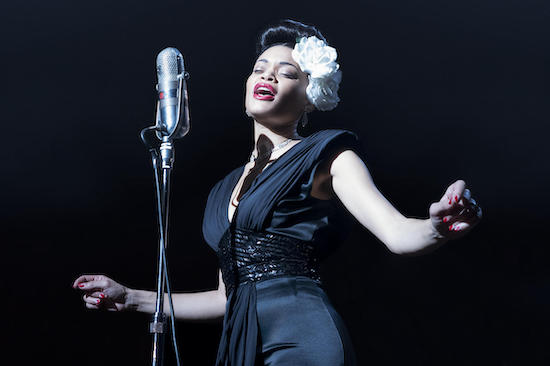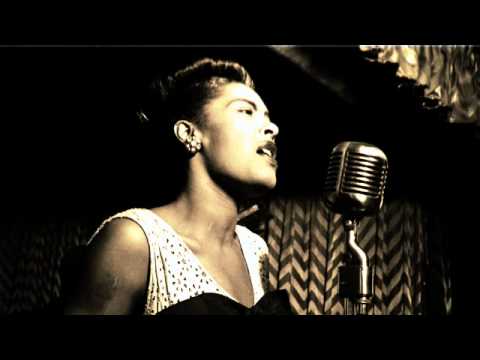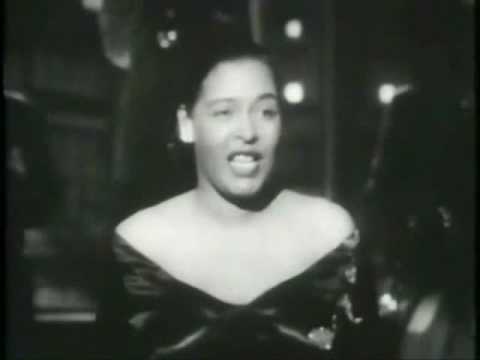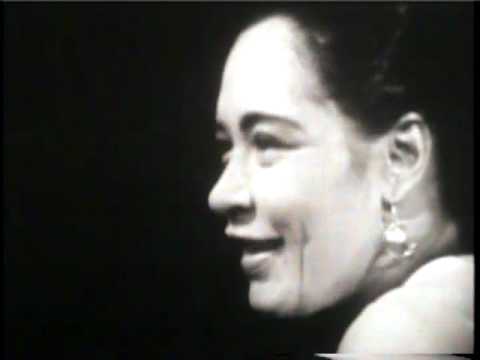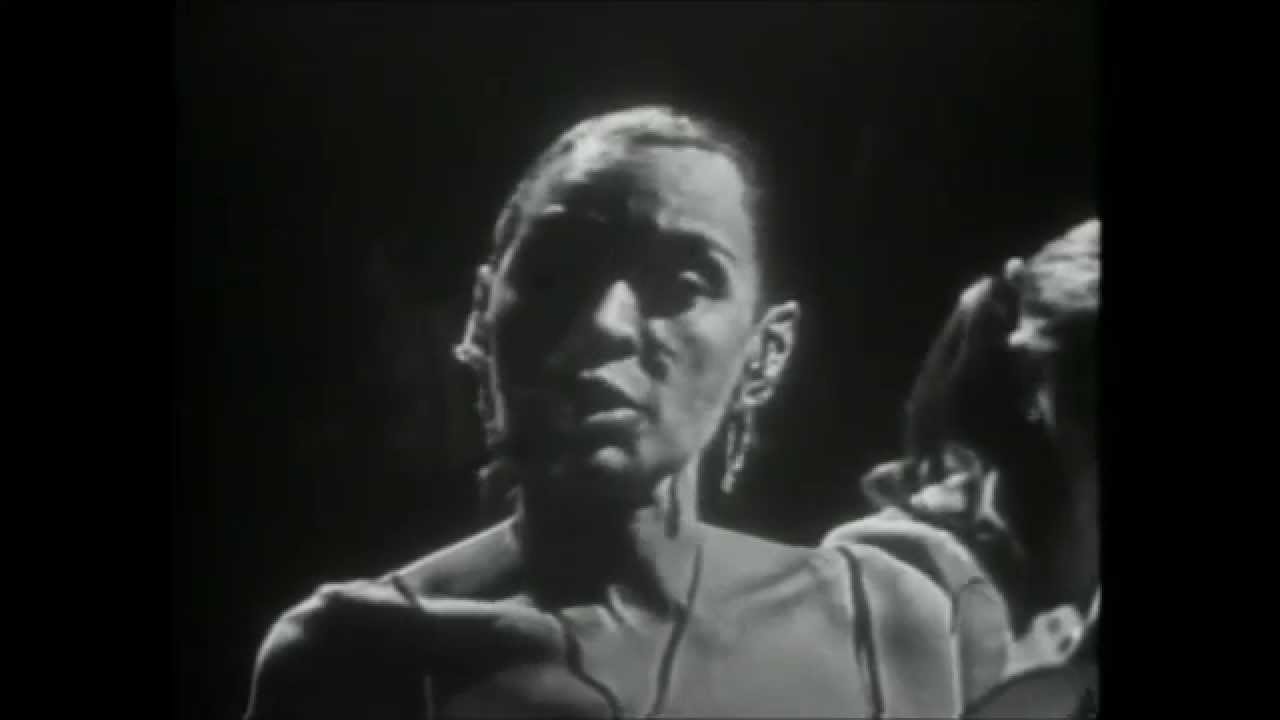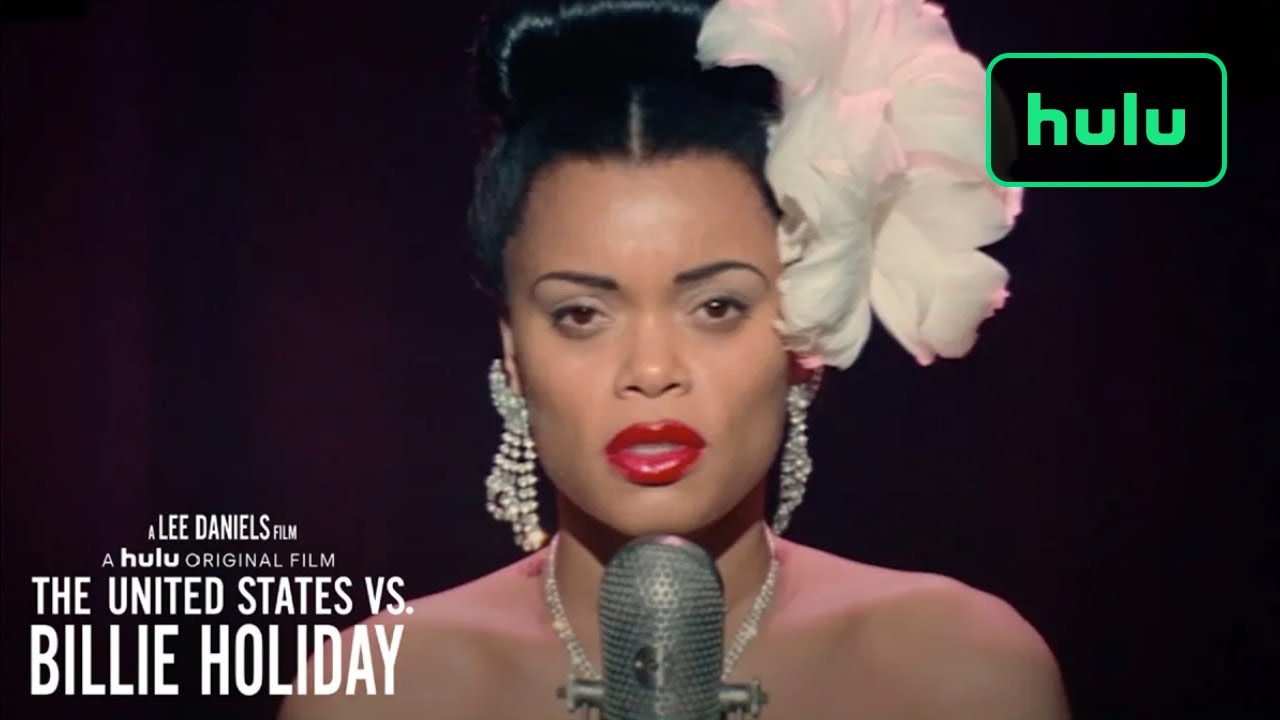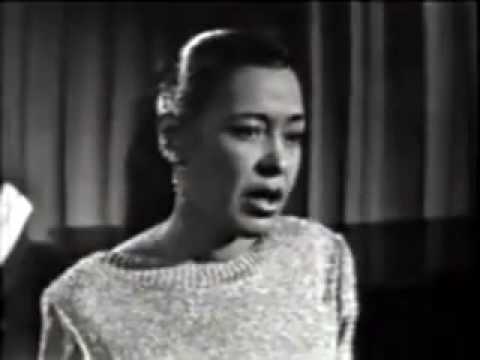Norman Granz writes on the liner of Songs For Distingué Lovers (1957) that Billie Holiday “happened to some songs”. From the moment she happened, mainstream culture has tried to explain away the transgressions that make Billie the seminal godmother of RnB queens and punks alike.
This 1959 obituary by Time magazine sums up the Establishment’s begrudging awe: Died. Billie Holiday, 44, Negro blues singer, whose husky, melancholy voice reflected the tragedy of her own life. Born of indigent teenagers, schooled in a Baltimore brothel, she stubbornly nursed her resentment ….
Tragic. Stubborn. Negro. Succeeding generations have canonised her as Lady Day and airbrushed her as a fashion icon (Vogue, in January 2021, assures us she is “about more than jazz”, as if jazz is a damp fart). Now filmmaker Lee Daniels, sheathing his pugnaciously soulful star Andra Day in Prada silk, presents her as a Black rights hero, risking reducing the harsh-throated hell-raiser to a shiny emblem.
Daniels’ film is painstakingly gorgeous. But gorgeousness did not save Billie. She may have been the first Black woman, in 1938, to tour with a white orchestra, but in Southern venues, Billie entered via the kitchen. Too pale for white audiences’ comfort, she was asked to black up. While Artie Shaw and his band crawled off to sleep in their white-only hotels, Billie Holiday slept in the car in her diamonds.
Sleeping peacefully was the privilege of others. Billie had learnt this at 10, when she was raped as she rested on a bed, lured by a kidnapper claiming to lead her to her mother. His attack earned Billie two days in a cell. The man eventually got three months. Billie was condemned for one year to the custody of nuns who punished her by locking her in a room with a dead body to cure the little girl’s “temper”. It was the first in a lifetime of wrongful and terrifying incarcerations – whether by a John she spurned as a sex worker, or by the U.S. government, who planted opium on her. On the other hand, Billie pimped other kids as a teenage prostitute. She loved bagging her first silk dress, as a 20-dollar whore. To glamorise her as Daniels does, without probing such contradictions, is to place her in another prison.
Before looking at Daniels’ film and, very briefly, its cousin, Billie, the gripping 2019 documentary by James Erskine, it seems fitting to explore Billie’s originality in a few of the songs she wrote herself.
Billie’s first recording, at 17 or 18, was not one of her own but ‘Your Mother’s Son-in-Law’ (1933) by Nichols & Holliner, a song that begs the singer’s lover to dignify her family by marrying her. Benny Goodman, the clarinettist band-leader sleeping with Billie, pursues a range better suited to his Columbia co-star Ethel Waters, the pet of white audiences and an exotic novelty, with her ‘Plantation Orchestra’. Goodman’s tootling introduction is completely overshot by Billie’s vocal attack. But by 1936, writing her song ‘Billie’s Blues’, Billie’s floozy, mighty disregard for tempo had been established.
The theme of ‘Billie’s Blues’ – an abusive man – is a lasting one. In her autobiography, Lady Sings The Blues, Holiday writes, “I’ve fought all my life to be able to sing what I want the way I want to sing it.” To clean up Billie Holiday is to rob her joy at turning shit into gold. This Commodore recording of her 1943 performance at Esquire’s All-American First Annual Jazz concert opens like a typical 12-bar blues. But Billie’s oozing vocals swiftly dissolve the traditional structure. She’s abetted by the rascally trumpet and beguiling tenor sax of Roy Eldridge and Coleman Hawkins. Billie dips and lags behind her own pungent lyrics:
I’ve been your slave baby
Ever since I’ve been your babe
But before I’ll be your dog
I’ll see you in your grave
Her lover starves her, burns her clothes and puts her on the street – as her pimp husbands did, to the end. But Billie has the last laugh, declaring her charms – her gaiety, wit and readiness for sex – with glee.
‘Billie’s Blues’ could be written off as ethnic license to pour out Black troubles – that’s what the blues was for. But messing with swing, the big band sound groomed for white ears, was another matter. Jo Jones, bandleader, drummer and pal, insists in the tapes heard on Erskine’s documentary that John Hammond, legendary producer of Billie, Bob Dylan and Bruce Springsteen, had Billie fired from Count Basie’s band, preferring that she “sing the blues, be a coloured Mammy.”
In ‘Now or Never’, the song co-written with Curtis Reginald Lewis and recorded for Decca in 1949, Billie growls and wheedles like a woman punched in the ovaries. Giving her lover an ultimatum, she manages to sound both brisk and lush, with the lushness triumphing. In this later version with Count Basie’s Sextet, her decision to sing a capella the line about calling her lover on the telephone (“I’ll count to twelve then I’ll be gone”), in the midst of a pumping rhythm, is the high-risk gambit of the terminally generous.
Projecting victory when losing; dragging the tempo, sinking the note, Billie makes wrong things sound right. Singing at the brink of degradation, she is unrepentant. In the 1957 CBS special The Sound of Jazz, she performs her song ‘Fine and Mellow’, grooving languidly through a matter-of-fact account of a toxic affair with the “lowest man that I’ve ever seen.” She loved actors (her affair with Tallulah Bankhead, with Natasha Lyonne criminally made up like a frowzy aunt from the P.T.A, is under-explored in Daniels’ film) and once said that she was more of a storyteller than a singer.
Encircled by a crew of jazz giants, including her equally ravaged best friend Lester ‘Prez’ Young, Billie’s storytelling pools around her damaged voice, culminating here in a brightly lit paraphrasing of W.C Handy’s blues classic ‘Loveless Love’. Billie replaces Handy’s “love is like a fire hydrant” line with “love is like a faucet”, a grimly funny acknowledgement of her ever-diminishing expectations.
‘God Bless the Child’, written with Arthur Herzog in 1939 and given the Grammy Hall of Fame Award in 1976, is probably Billie’s greatest composition: unsentimental, poignant and phrased with killer sass. But the song that best expresses her contradictions is ‘Don’t Explain’, also written with Herzog and recorded in 1944. Though this song is ostensibly addressed to a man who’s come home marked with lipstick – a proxy for her sketchy husband Jimmy Monroe – it shadows Billie’s own “lumps and scars,” as she calls them, in her autobiography.
‘Don’t Explain’ began life as a hushed howl, Billie’s vocal tearing slowly like a silk dress over sumptuous strings. By 1958, in this televised performance, she replaces the line that begs her man to remain, with “I know you raised Cain.” The figure raising Cain is Billie, deploying a capella to delve into the dark spaces of the cabaret-style piano. She’s fragile, tormented and amused. Throat cords straining, she raises one eyebrow before snapping off the hell of being Billie.
And then there’s ‘Strange Fruit’, the cause célėbre of Daniels’ new film and the most influential anti-racist song in history. Daniels’ story is that Billie was targeted by the Narcotics squad to stop the song leading a revolution. Billie’s own story was that Abel Meeropol (pen name Lewis Allen), a Jewish Communist, brought her “this poem”, one night at Café society, the daringly mixed-race club owned by another radical white Jew, Barney Josephson. Writing about her first encounter with ‘Strange Fruit’ in her autobiography, Billie said she “dug it right off. It seemed to spell out all the things that had killed Pop.” So she, Meeropol, Sonny White and Danny Mandelsohn worked it into a song.
It was true that Clarence Holiday had died after being refused hospital treatment for being Black (a fate the U.S. government would visit, in an altered guise, upon Billie). But Billie’s relationship with her absent Pop was distant. This “poem”, which Lee Daniels, too, echoing Billie, has claimed “nobody else was singing” was already an underground protest anthem, albeit not the finished piece we have today. The first Black woman to sing it was Laura Duncun at Madison Square Garden. It was Josephson who pressed Billie to sing this bewitching lament, in which a lynch victim’s body swings in the Southern breeze. She didn’t want to touch it but Josephson insisted she perform it nightly, with the waiters retired, the lights low and no encores. The audience’s pause after the song disturbed even Billie.
"People had to remember ‘Strange Fruit’, get their insides burned by it,” Josephson said. But it was Billie who burned – and perhaps recognised the danger of singing ‘Strange Fruit’ better than a white impresario. “The first time I sang it, I thought it was a mistake,” she recalled in her autobiography. “There wasn’t even a patter of applause when I finished. Then a lone person began to clap nervously. Then suddenly everyone was clapping….”
The song grew roots in the tangle of Billie’s losses, making her violently “sick” and “depressed”, as she recalled in the same book, whenever she performed it; but it was also a moment of nightclub theatre. Over the years, as her voice got huskier and haggard, she sang it better and angrier. She wrote it into booking contracts. She called it her “personal protest”. It was art. It was showbiz. It was real – but the reality, under the duress of constant FBI intimidation, got more fucked up as Billie did.
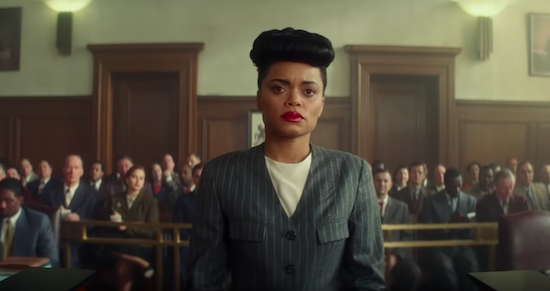
Lee Daniels struggles to express this complexity in his glossy, frequently engaging film, despite the meaty central performance from Andra Day. She constructs a nervy, cackling, streetwise and magisterial and very human Billie, inured to domestic sexual violence and greying on the inside.
Daniels has said he loves beauty. So did Billie. But, as she wrote, she hated being forced to use her looks to win approval while feeling distressed: “I’m not supposed to get sick… I’m supposed to get out there and look pretty and sing good and smile and I’d just better.
“Why? Because I’m Billie Holiday and I’ve been in trouble.”
If the shoehorning of Billie’s personal horrors into the film’s visual splendour is intended to be troublingly seductive – Billie in buttercup silk, hunkering with her poodle down a rainy street under an aubergine umbrella; Billie singing with broken ribs in dusky pink chiffon – it’s a technique scuppered by the film’s politics. Daniels’ approach is all surface and sensation, while writer Suzan-Lori Parks screeches her polemic about government racism through a linear time frame that doesn’t linger on those conflicts of character that made Billie’s music unique. Nor do we see the steelier aspects of Billie’s addiction. Sure, she shoots up in exquisite lingerie in club loos. Andra Day’s sinewy face looks like she could do worse, but ultimately she glows charismatically, while Daniels’ camera dwells on matching dress and wallpaper swatches. The episode where Billie strips naked during a drug bust rather than be strip-searched is factually based, but we don’t see her urinate on the floor, as she really did. Speaking to The Roots Institute, Daniels has said that Billie was “not just a jazz singer or a drug addict” but “a civil rights leader.” Evidently, pissing on the floor is not how a civil rights leader should behave.
This political white-washing results in wooden dialogue that stymies the film’s full-blooded cast. Parks particularly fails the FBI villains. Cardboard antagonists, they speak to each other only of “nigger-hatred”, and “nailing that bitch”.
It’s well-documented that Billie was targeted by FBI narcotics chief Harry Anslinger and Colonel George White, both of them extreme racists, the latter a government-approved murderer and date-raper. When she was in withdrawal in hospital suffering from liver damage, they cuffed her to the bed and removed her methadone, causing heart failure. White wrote of how he hated “her fancy coats and fancy automobiles and her jewellery… she was the big lady wherever she went.” In response to their obsession, the film mounts a defence of Chinoiserie, crystal and costumes by Miuccia Prada. Daniels’ view of Black justice appears sponsored by Vogue – indeed, Anna Wintour was his fashion advisor.
Meanwhile, his Billie scoffs at squares who only want to hear winsome numbers like her hit, ‘All of Me’. Yet it’s this song, rather than ‘Strange Fruit’, that is his film’s theme tune. For, lo and behold, a nice Black boy from a wealthy home arrives to cure Billie’s craving for doggy-style abuse with sweet kisses and cunnilingus.
Billie and Jimmy Fletcher, the Black FBI agent put on her tail, were close, possibly romantically, but making this affair the emotional crux of the film undermines its overstated mission to reveal how ‘Strange Fruit’ destroyed Billie.
Maybe, in Billie’s coded autobiography, it’s Fletcher who would, or did, “gladly sleep with me inside the Federal building”. But the film suggests that all this bad girl needed was a man to treat her right. It’s ridiculously patronising to have Billie waltz wistfully around her impeccable jade and amber dressing room, telling Jimmy that ‘Strange Fruit’ is “about important things”. Andra Day’s eventual performance of the song is prefaced by an overwrought, hallucinatory sequence of drug-taking between the lovers. It tastelessly blends a lynching with Billie’s childhood, and turns Fletcher into a dream NA sponsor. Psychological upheaval supposedly purged, Day is zipped into her most über Billie costume – red vinyl lips and silvery eyes framed by enormous white lilies and clinking diamante. Day’s a capella singing burns. She grimaces with sarcasm, preening like exuberant prey. It’s a sinister performance but, accompanied by a swish orchestra, it’s phrased to thrill.
By contrast, singing ‘Strange Fruit’ at the end of her life, Billie lurks low in her destroyed voice, watching her own destruction and luring us into her horror.
She elides words with an eerie nonchalance that develops into a hypnotic, warm growl. Her slurring warmth is disarming, for when she finally rips into the notes, yawping as the body drops, we feel ourselves falling with her, quailing helplessly.
Billie wrote that at 13, “I wasn’t going to do anything or say anything unless I meant it.” Erskine’s documentary, assembling Linda Kuehl’s tapes of colleagues like Jo Jones, John Hammond, Count Basie and Jimmy Fletcher, comes closer to the Billie who was more concerned with what she wanted to say than what others would prefer she said. Yes, Billie Holiday protested the murders of Black people, unto her death. Yes, she was “just a jazz singer”, whose streetwise style of bleeding a lullaby was expressly emulated by Frank Sinatra. But she was also a queer masochist who clung to savage men. She was an addict who took heroin to remind herself that she existed. She was suicidally depressed, writing in her autobiography that if it wasn’t for her public, “I could kill myself.” Billie wrote too in her autobiography, that “If I did anything wrong, I’d come out and admit it.” However messy such facts might be, Daniels admits too little and tries to make all the wrongs right. That wasn’t Billie Holiday’s style.

